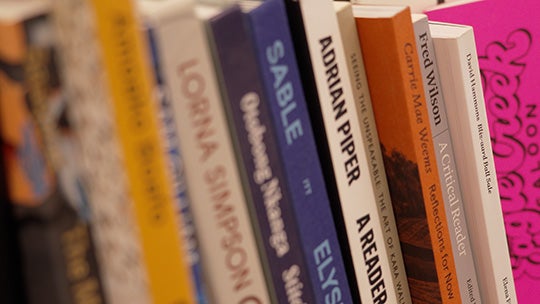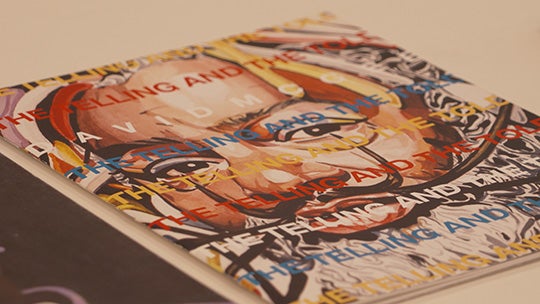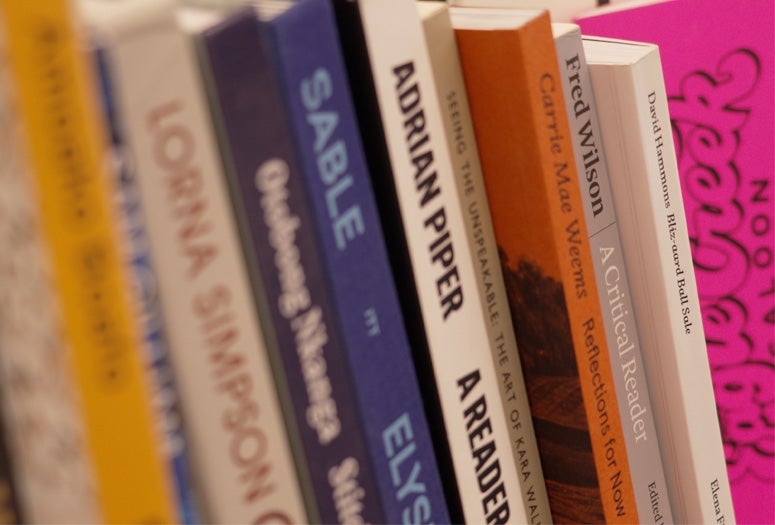The Moody Center for the Arts’ summer exhibition “Figurative Histories” invites viewers to reflect on the Black figure in contemporary art — its presence, its absence and its power. And just steps from the main galleries, a literary experience offers a complement to visual exploration: The Reading Room HTX, a Black art and culture reference library curated by Houston-based writer and archivist Amarie Gipson.
“We asked The Reading Room to partner with us because we recognized the parallels of community impact found in the artworks on view and in Amarie’s work,” said Alison Weaver, co-curator of “Figurative Histories” and Rice University’s Suzanne Deal Booth Executive Director of the Moody. “Through this collaboration, our guests have access to an amazing array of resources in a quiet, welcoming space, and that helps us extend the educational component of our mission.”
Located in Room 103, The Reading Room HTX is a pop-up installation of Gipson’s independent library of more than 700 books. Visitors are encouraged to browse, read and linger, connecting the work they see on the gallery walls to broader histories and artistic traditions through literature.

“I’ve been building this collection of books since I was a senior in high school, and when I moved back to Houston a few years ago, I wanted to find something to do outside of my home,” Gipson said. “Starting a library seemed like the natural thing to do for me.”
The Reading Room HTX began as a virtual resource. Without access to a physical space, Gipson cataloged her personal collection — 325 books at the time — by scanning covers and creating searchable categories. What started online eventually took physical form in community spaces across Houston and beyond.
“It moves, it roves, it’s flexible, but the mission is to increase access to Black art and culture,” Gipson said. “I remember at the very first pop-up experience that I did after The Reading Room HTX launched, someone came up to me and said, ‘I didn’t even know this many books on Black art even existed.’ And I was like, ‘That’s why we’re here. That’s the whole reason. That’s the whole purpose.’”
At the Moody where “Figurative Histories” centers the Black body as a subject of memory, intimacy and resistance, The Reading Room HTX functions as a complementary space for research and dialogue. Gipson sees it as a bridge connecting the art on display to the historical and cultural forces that shaped it.

“Nothing happens in a vacuum,” Gipson said. “Every single artist and everything that we create as human beings exists in a continuum. There are, of course, people who have pioneered certain ways of making art, taking photographs, silhouettes, all of these different styles. I think having the library here is important because you can come in and get a little bit more history or information than you might have expected.”
The Reading Room HTX pop-up at the Moody is part of a larger effort by Gipson to create accessible cultural spaces. In addition to the pop-ups, she operates a semipermanent version of the library in Sanman Studios, an art hub in downtown Houston. That space is open weekly and welcomes visitors who treat it as both study space and sanctuary.
“It’s a community space,” Gipson said. “The emphasis is not really on the books — it’s on people. How do the books help tell stories about how we relate to one another, what’s happening in our society, what do we need to know about history to navigate through all of these changes?”
The public is welcome to explore The Reading Room HTX through Aug. 16 during regular Moody hours. Learn more here.

